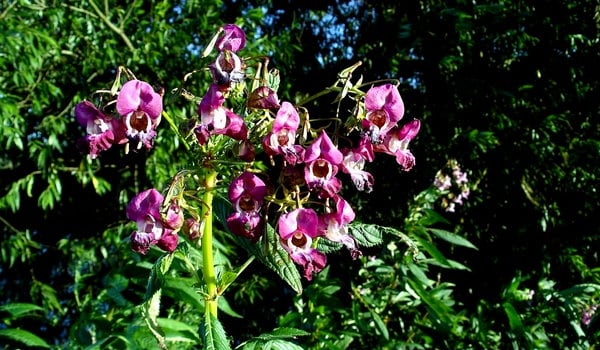Another non-native plant species is taking the UK by storm. Like Japanese knotweed and other alien species, Himalayan Balsam was originally imported as a decorative plant in the 19th century. If you have travelled along our rivers, you have doubtless seen this striking plant and the havoc it causes.
Up to this point, Himalayan, like Japanese knotweed, has proven one tough customer to remove. To eliminate the plant, some of the most powerful weed killers have been ineffective. Eradicating Himalayan Balsam is a mammoth task for those who attempt the process manually. This is one of the UK’s most prolific invasive species.
For example, the innocent and appealing little pink flowers can each produce about 800 seeds. The plant can spread these seeds over a 20 foot radius. This gives the species striking capacity to spread, dominate the landscape and eliminate native plants.
As if this was not problem enough, the plant populates in moist areas, loves river banks and is quick to erode the soil wherever it grows. This is now posing a serious threat to UK riverbeds and has received the full attention of scientist and the Ministry of the Environment. 13 percent of the riverbeds in England and Wales have been eroded when the soil is laid to waste and the Himalayan Balsam dies in Winter.
Minister of Environment
The Minister of Environment on behalf of the Environment Agency is clearly concerned about the condition of UK rivers. The plant puts our rivers at risk of flood and further erosion.
Lord de Mauley, minister for the natural environment, proclaimed that removal of the plant could cost up to £1 million per year. Other environmentalists estimate the cost of removal at significantly higher; as much as £300 million in total.
CABI Intercedes
Anxious to put an end to the spread, the erstwhile research firm CABI has been testing the effect of a rust fungus on the plant. CABI set out to identify a natural predator for the species eight years ago. The idea was to identify a fungi that could attack and remove the alien species in the wild without damaging native plants.
The identification and research process has been gruelling. The original commission chartered CABI to find a fungus or insect that was a natural predator for the species. Coincidentally, similar research revealed an insect that is being tested to remove Japanese knotweed. It remains to be seen how effective rust fungus will prove to be.
However, recently CABI released its first tests at chosen locations in Cornwall, Berkshire and Middlesex. CABI executive Richard Tanner explained the firm’s goal; “Over time, we should see a decline in the Himalayan balsam populations along our rivers, with native plant species re-colonising these degraded sites.”
Tanner was quick to note and enforce the idea that the species poses a serious threat to taxpayers and to the economy. If the rust fungus proves effective, it will be distributed to thousands of other locations as soon as possible. Tanner described rust fungus as, “a great step forwards in tackling Himalayan Balsam.”
Anyone who has ever attempted to eliminate either Japanese knotweed or Himalayan Balsam from their property manually understands what a challenge these two plant species offer. In the UK, waste from removal of these species must be controlled and can only be dumped at approved landfills. Even licensed contractors say that the removal process can take three to four years of repeated treatments and removals. This is simply too big a task for the typical homeowner or commercial property owner.
If you would like assistance in removing Himalayan Balsam or any other invasive plant species from your property, get in touch with TP knotweed today. You can call 0800 389 1911 or contact us online.




